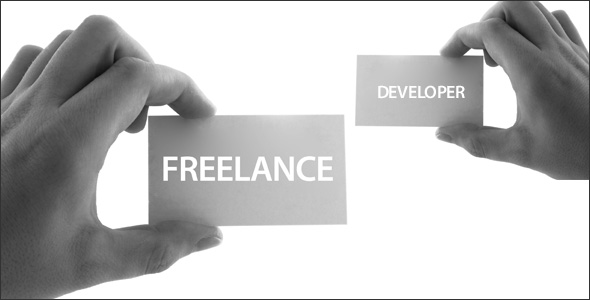Guest post by Jonathan Judge, founder of Codacity.
Let’s face it. The Internet was supposed to make life easier for everyone. And in the age of Amazon, small businesses need to harness the potential of the web more than ever before to compete effectively.
Yet it seems, as small business owners, we’re left with limited, cookie-cutter options (a la GoDaddy), or worse, outsourcing to a web agency in another country.
Then, of course, we look cautiously at the middle option, and that’s the freelance web developer and web designer. Problem solved! Right?
Well, in a lot of experiences, it’s more trouble than it’s worth, unless you know exactly what to look for.
So how can small businesses make better decisions about how and when to hire web developers and web designers?
As a web professional and small business owner who has made these mistakes on both sides of the table, here are 5 solid tips on the do’s and don’ts for hiring freelance web talent.
1. DO set a budget and timeline first
Asking for quotes on a project before knowing how much you’re willing to spend and when you need it by is not very practical.
Yet this happens more often than people would think.
You should figure out exactly what the end product is supposed to do for you. Then set your maximum budget based on what you think you could get out of it at minimum over time.
Moreover, find out how much time you can buy with your budget, and ask to see your prospective hire perform a little bit of work for you in person to assess their chops before committing for the long haul.
2. DON’T mistake moonlighting for freelancing
We all have that friend who knows a developer or designer whom we can hire on the weekends or evenings.
But when we need that person the most, it seems they’re not available for days, weeks or even months because of the commitment that their actual full-time job demands.
Consider your needs for the short-term and long-term. If you’re hiring for a quick job and don’t care if you ever see or hear from that person again, that’s fine.
However, if you even think you’ll need more than that, look for someone who has chosen full-time freelancing and can be there to support you in the months to come.
3. DON’T reinvent the wheel
The web has given birth to many great apps, services, and platforms.
For instance, using Squarespace for a quick website saves a lot of development and design time. Shopify is a fantastic ecommerce platform with many apps and themes that can be customized. WordPress is the holy grail because anyone can use it for practically anything.
Most importantly, companies and foundations exist to support and improve these platforms 24/7.
If a solution exists for you and you don’t know how to set it up or incorporate it properly into your existing website or business, that’s a good time to consider hiring a developer or designer.
If you don’t know what to choose, ask as part of a consultation what app or platform can be used to minimize the amount of development and design time necessary to get the job done.
ALSO: Resist the temptation to engage a developer in making an app or platform for you from scratch just to get a handful of features that work exactly the way you want them to.
Some developers will happily work on customizing a solution to give you exactly what you want.
However, when you do that, you have to ask yourself, will this developer be around to support this product year-round? How much will that potentially cost? (Tends to be a lot.) What if you suddenly need a new feature designed and implemented and the developer has moved on to other projects?
Unless you’re getting in the business of building and maintaining an app or platform, stick to what works out of the box until you know exactly what you need, why you need it, and whether it’s worth the investment.
4. DON’T hire single-skill freelance web talent, unless you know that’s exactly what you need
For small business projects, a web developer who only knows how to code is about as helpful as a designer who only knows how to use Photoshop.
Yet no project will happen successfully without employing both skill sets.
Those who are proficient in just one skill are best suited to working in teams, not solo on small business freelance projects.
Unless you plan on hiring a minimum of two or three professionals for your project, look for full-stack web developers who know about UI/UX design, or web designers who understand how to build interactive and device responsive templates.
Chances are, one person’s work will have big implications on how everything else performs, so having someone who can see the whole picture as opposed to one small piece of it can make all the difference.
5. DO insist on working collaboratively in real time
Have you ever waited days or weeks for turnaround on progress or changes, and then had to renegotiate while going beyond deadline and over budget?
Don’t strain your budget and your timelines by hiring developers and designers who work at different times than you.
The growing Lean/Agile design and development standards smartly require a large degree of real-time feedback and interaction with clients.
Why? Because only you, the client, can say whether a task has been completed right.
Most tasks can be broken down into one or two hour sets. As long as you’re generally available in person or by phone during the time your freelancer is working in order to review progress, immediate feedback and immediate changes will keep your budgets low and save everyone’s time.
Following these 5 freelance web talent tips can help you go a long way in making technology work strategically for your small business.
This post originally appeared on Codacity on August 19.
________________

Born and raised in Brooklyn, Jonathan has devoted his career to helping people solve problems through technology, web design and web development.
He acquired his passion for service throughout his studies at Xavier High School, CUNY Macaulay Honors College at Brooklyn College, and New York University. A true techie at heart, he has relentlessly pursued technological solutions to figure out how can we do better what we need to do. This drive led Jonathan to establish Codacity LLC in 2011, where he is currently Owner and Chief Solutions Architect. Previously, Jonathan worked in web design and web development with Disney, Time Inc, the City of New York, and numerous small businesses and non-profits in Brooklyn and beyond. He continues to reside in the Kensington section of Brooklyn.






